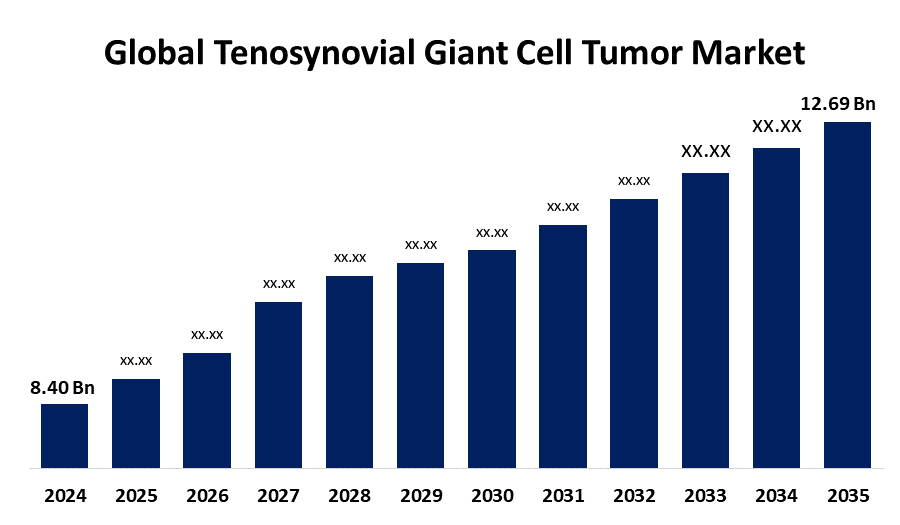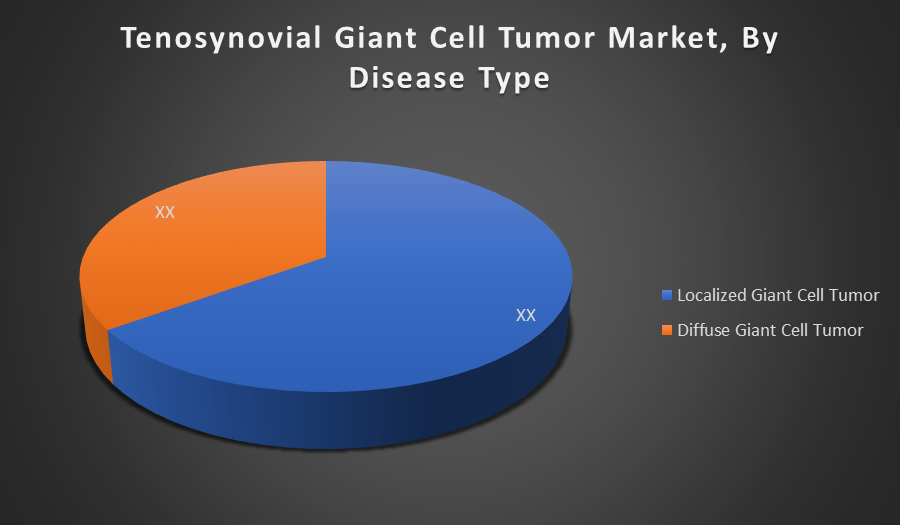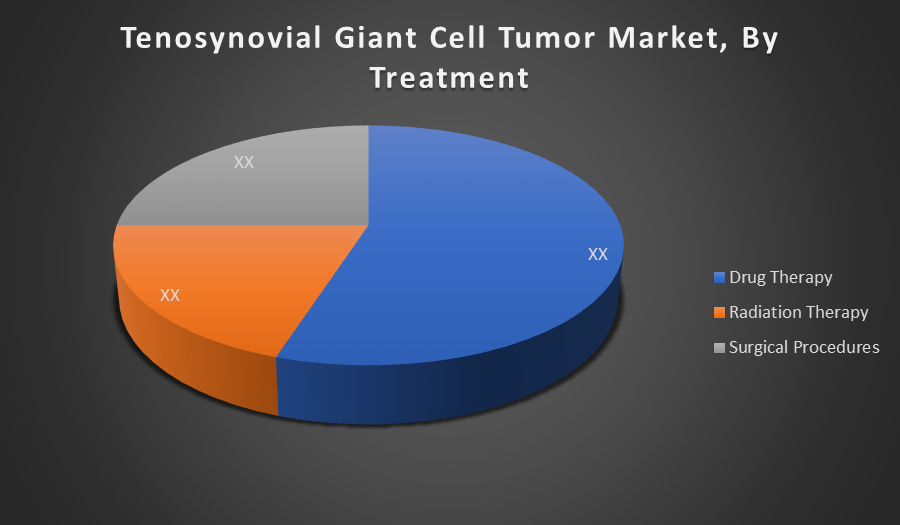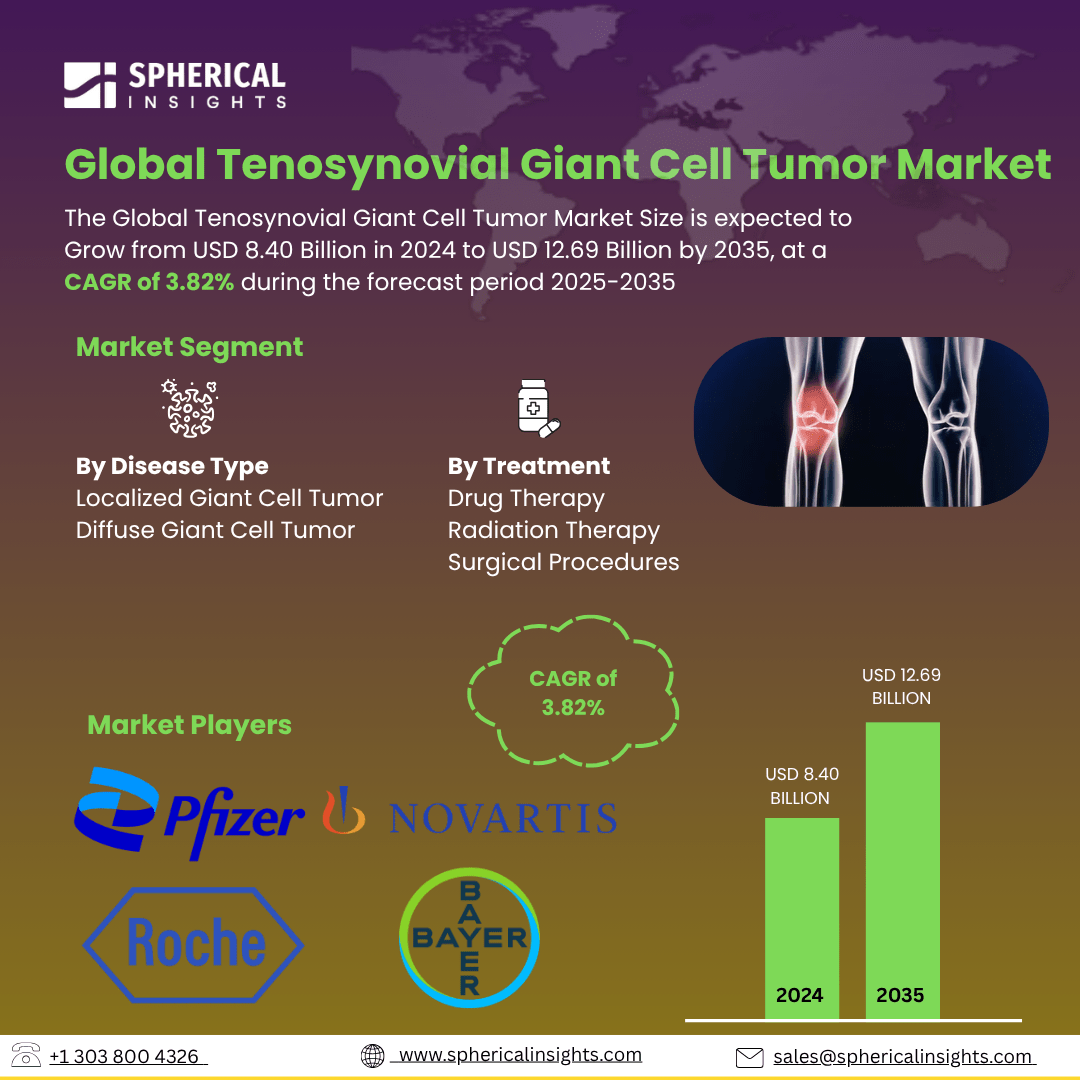- As per Spherical Insights & Consulting, The Global Tenosynovial Giant Cell Tumor Market Size is expected to Grow from USD 8.40 Billion in 2024 To USD 12.69 Billion by 2035, at a CAGR of 3.82% during the forecast period 2025-2035, owing to the launch of new therapies in the market and the rise in the number of cases.
- The leading Tenosynovial Giant Cell Tumor Market Companies such as Pfizer Inc., Novartis AG, Roche Holding AG, Bristol Myers Squibb Company, Johnson & Johnson Services Inc., Bayer AG, Daiichi Sankyo Company Limited, Eli Lilly and Company, Merck & Co., Amgen Inc., Deciphera Pharmaceuticals Inc., Abbisko Therapeutics, Elixiron Immunotherapeutics, SynOx Therapeutics Limited, Five Prime Therapeutics, and Other

Tenosynovial Giant Cell Tumor Treatment Market: Understanding and Treatment Algorithm:
Tenosynovial Giant Cell Tumor (TGCT) is a rare, typically non-cancerous tumor that arises in the joints, tendon sheaths, or bursae. It is caused by overproduction of colony-stimulating factor 1 (CSF1), leading to joint pain, swelling, and limited mobility. TGCT can be localized or diffuse and often requires targeted treatment.
Tenosynovial Giant Cell Tumor Diagnosis:
Diagnosis involves clinical evaluation, imaging techniques like MRI or X-rays to detect joint abnormalities, and histopathological examination through biopsy. MRI is particularly useful in identifying the tumor's size and location, while biopsy confirms the diagnosis by revealing characteristic giant cells and synovial proliferation.
Tenosynovial Giant Cell Tumor Treatment
Treatment for Tenosynovial Giant Cell Tumor (TGCT) depends on its type and severity. Localized TGCT is typically managed with surgical removal. Diffuse TGCT may require a combination of surgery and targeted therapies, such as CSF1R inhibitors like pexidartinib or vimseltinib, to reduce tumor size and improve joint function.
Tenosynovial Giant Cell Tumor Epidemiology
The disease epidemiology covered in the report provides historical as well as forecasted epidemiology segmented by Total Diagnosed Incident Population of Tenosynovial Giant Cell Tumor, Gender-specific Diagnosed Incidence of Tenosynovial Giant Cell Tumor, Type-specific Diagnosed Incidence of Tenosynovial Giant Cell Tumor, Age-specific Diagnosed Incidence of Tenosynovial Giant Cell Tumor, Diagnosed Incident Population based on Primary Site of Tenosynovial Giant Cell Tumor, and Diagnosed Incident Population based on Histologic Classification of Tenosynovial Giant Cell Tumor Tumour in the global market covering North America, Europe, Asia-Pacific, Latin America, the Middle East, and Africa from 2024 to 2035.
Principal Insights
This section offers a global overview of tenosynovial giant cell tumor epidemiology in major markets worldwide.
Country Wise- Tenosynovial Giant Cell Tumor Multiforme Epidemiology
- The epidemiology segment provides Tenosynovial Giant Cell Tumor prevalence data and findings across key regions worldwide, including North America, Europe (Germany, France, Italy, Spain, and the United Kingdom), Asia-Pacific (including Japan), Latin America, the Middle East, and Africa.
Tenosynovial Giant Cell Tumor Recent Developments:
- In February 2025, Deciphera Pharmaceuticals (now part of Ono Pharmaceutical) received full FDA approval for Romvimza (vimseltinib) to treat adult patients with symptomatic tenosynovial giant cell tumor (TGCT) unsuitable for surgery. The approval followed robust Phase 3 MOTION trial results, which showed a 40% objective response rate and significant quality-of-life improvements.
Tenosynovial Giant Cell Tumor Marketed Drugs:
Turalio (pexidartinib) is an oral CSF1R inhibitor approved by the FDA for the treatment of adults with symptomatic TGCT not amenable to surgery. It blocks the CSF1/CSF1R signaling pathway, helping reduce tumor growth and joint-related symptoms in diffuse TGCT cases.
- Romvimza: Deciphera Pharmaceuticals / Ono Pharma
Romvimza (vimseltinib) is a selective oral CSF1R inhibitor approved for symptomatic TGCT in adults where surgical treatment is not recommended. It has demonstrated improved tumor response and mobility outcomes in Phase 3 trials and offers a new, non-surgical therapeutic option.
- Iadademstat: Oryzon Genomics
Iadademstat is an LSD1 (lysine-specific demethylase 1) inhibitor being explored for its anti-tumor properties. Although primarily in clinical trials, it shows potential in targeting tumor growth mechanisms relevant to TGCT, aiming to provide an epigenetic-based therapeutic approach.
Tenosynovial Giant Cell Tumor: Emerging Therapies
- BMS-986258: BMS-986258 is a monoclonal antibody targeting CSF1R, currently in clinical trials for Tenosynovial Giant Cell Tumor. It aims to inhibit tumor growth by blocking CSF1R signaling, potentially improving outcomes in patients resistant to existing therapies.
- Pimicotinib (ABSK021): Pimicotinib is an oral CSF1R inhibitor in late-stage trials for TGCT. It blocks the CSF1/CSF1R pathway to reduce tumor proliferation and inflammation, showing promise as a targeted treatment option with improved safety profiles.
- Emactuzumab: Emactuzumab is a monoclonal antibody targeting CSF1R, currently under investigation for TGCT treatment. It works by depleting tumor-associated macrophages to reduce tumor size and symptoms, showing encouraging results in early clinical trials.
- PLX7486: PLX7486 is an oral kinase inhibitor targeting CSF1R and other kinases. It is being studied for TGCT to block tumor growth pathways, potentially offering a novel therapeutic option with enhanced efficacy and tolerability.
Tenosynovial Giant Cell Tumor Market Outlook
- The Tenosynovial Giant Cell Tumor (TGCT) market involves the development, production, and commercialization of therapies and diagnostic tools for TGCT, a rare, benign tumor affecting the synovium of joints, causing pain, swelling, and impaired mobility, driving demand for effective treatment options globally.
- Key drivers of the market include increasing prevalence of TGCT, growing awareness about rare joint disorders, advancements in targeted therapies, rising demand for non-surgical treatment options, and expanding research activities focused on improving patient outcomes and reducing tumor recurrence rates.
- Opportunities in the market arise from the development of novel targeted therapies, expanding clinical trials, unmet medical needs in rare joint tumors, growing investments in biotechnology, and increasing collaborations between pharmaceutical companies and research institutions to enhance treatment effectiveness and accessibility.
- Governments worldwide have launched initiatives supporting rare diseases like tenosynovial giant cell tumor, including financial aid, specialized treatment centers, and awareness programs, aiming to improve diagnosis, treatment access, and reduce patient financial burden globally.
- Limited awareness and high treatment costs hinder effective management of tenosynovial giant cell tumor globally.
- Rising prevalence and advancements in targeted therapies are driving the growth of the tenosynovial giant cell tumor market.
By Disease Type:
- Localized Giant Cell Tumor
- Diffuse Giant Cell Tumor

The Localized Giant Cell Tumor segment holds the largest market share due to its higher diagnosis rates and more straightforward treatment options. Its limited spread allows for targeted therapies and surgical interventions, leading to better patient outcomes and driving greater demand compared to the more complex diffuse type.
By Treatment:
- Drug Therapy
- Radiation Therapy
- Surgical Procedures

The Drug Therapy segment dominated the market due to the increasing adoption of targeted treatments that offer less invasive options and better patient outcomes. Advancements in medications and growing preference for pharmacological management over surgery or radiation have boosted demand, making drug therapy the leading treatment choice for Tenosynovial Giant Cell Tumor.
Regional Segment Analysis of the Tenosynovial Giant Cell Tumor Market
North America holds the largest share in the tenosynovial giant cell tumor market due to its well-established healthcare infrastructure, high patient awareness, and presence of numerous leading pharmaceutical and biotechnology companies. The region benefits from significant investments in research and development, early adoption of innovative targeted therapies, and strong regulatory support, all of which contribute to market dominance. Additionally, widespread insurance coverage and advanced diagnostic facilities further drive the growth and accessibility of treatment options in North America.
The Asia-Pacific region is the fastest-growing market for tenosynovial giant cell tumor, fueled by increasing healthcare expenditures, rising prevalence of the disease, and growing patient awareness. Rapid economic development in countries like China and India has led to improved healthcare infrastructure and better access to modern therapies. Government initiatives aimed at supporting rare diseases, along with expanding clinical trial activities and collaborations with global pharmaceutical companies, are also accelerating growth. The region's large population base and increasing demand for advanced treatment options present significant opportunities for market expansion.
Tenosynovial Giant Cell Tumor Market Key Companies
- Pfizer Inc.
- Novartis AG
- Roche Holding AG
- Bristol Myers Squibb Company
- Johnson And Johnson Services Inc.
- Merck And Co.
- Amgen Inc.
- Deciphera Pharmaceuticals Inc.
- Abbisko Therapeutics
- Elixiron Immunotherapeutics
- SynOx Therapeutics Limited
- Five Prime Therapeutics
- Others
Tenosynovial Giant Cell Tumor Therapeutics Market Report Scope
- The Tenosynovial Giant Cell Tumor therapeutics market report provides a detailed overview, covering its causes, symptoms, disease progression, and existing treatment options.
- Detailed insights into Tenosynovial Giant Cell Tumor’s epidemiology and therapeutic approaches are included.
- Additionally, a comprehensive review of existing and emerging Tenosynovial Giant Cell Tumor therapies is provided, including an evaluation of new treatments expected to influence the current Tenosynovial Giant Cell Tumor treatment market landscape.
- The report includes a detailed review of the Tenosynovial Giant Cell Tumor therapeutics market, both historical and forecasted, highlighting the global drug reach.
- The Patient-Based Tenosynovial Giant Cell Tumor Market Forecasting report offers valuable insights into trends shaping the global Tenosynovial Giant Cell Tumor market, helping to develop effective business strategies.
Tenosynovial Giant Cell Tumor Treatment Market Report Insights
- Forecasting Market Trends Based on Patient Data and Disease Rates
- Tenosynovial Giant Cell Tumor Therapeutic Approaches in Tenosynovial Giant Cell Tumor
- Review Of Drugs in Development for Tenosynovial Giant Cell Tumor
- Market, Growth, and Trends in Tenosynovial Giant Cell Tumor
- Market Opportunities in Tenosynovial Giant Cell Tumor Treatment
- Effects Of Future Therapies on Tenosynovial Giant Cell Tumor Treatment.
Tenosynovial Giant Cell Tumor Treatment Market Report Key Strengths
- 15 Years Tenosynovial Giant Cell Tumor Market Forecast
- Global Coverage
- Tenosynovial Giant Cell Tumor Epidemiology Segmentation
- Key Cross Competition
Tenosynovial Giant Cell Tumor Treatment Market Report Assessment
- Present Practices in the Tenosynovial Giant Cell Tumor Treatment Market
- Review of Investigational Tenosynovial Giant Cell Tumor Drugs
- Attractiveness of the Tenosynovial Giant Cell Tumor Drug Market
- Tenosynovial Giant Cell Tumor Market Drivers
- Tenosynovial Giant Cell Tumor Market Barriers
- SWOT
- Attribute Analysis
Market Segment
This study forecasts revenue at the global, regional, and country levels from 2020 to 2035. Spherical Insights has segmented the tenosynovial giant cell tumor market based on the below-mentioned segments:
Global Tenosynovial Giant Cell Tumor Market, By Disease Type
- Localized Giant Cell Tumor
- Diffuse Giant Cell Tumor
Global Tenosynovial Giant Cell Tumor Market, By Treatment
- Drug Therapy
- Radiation Therapy
- Surgical Procedures
Global Tenosynovial Giant Cell Tumor Market, By Regional Analysis
- North America
- Europe
- Germany
- UK
- France
- Italy
- Spain
- Russia
- Rest of Europe
- Asia Pacific
- China
- Japan
- India
- South Korea
- Australia
- Rest of Asia Pacific
- South America
- Brazil
- Argentina
- Rest of South America
- Middle East & Africa
- UAE
- Saudi Arabia
- Qatar
- South Africa
- Rest of the Middle East & Africa






